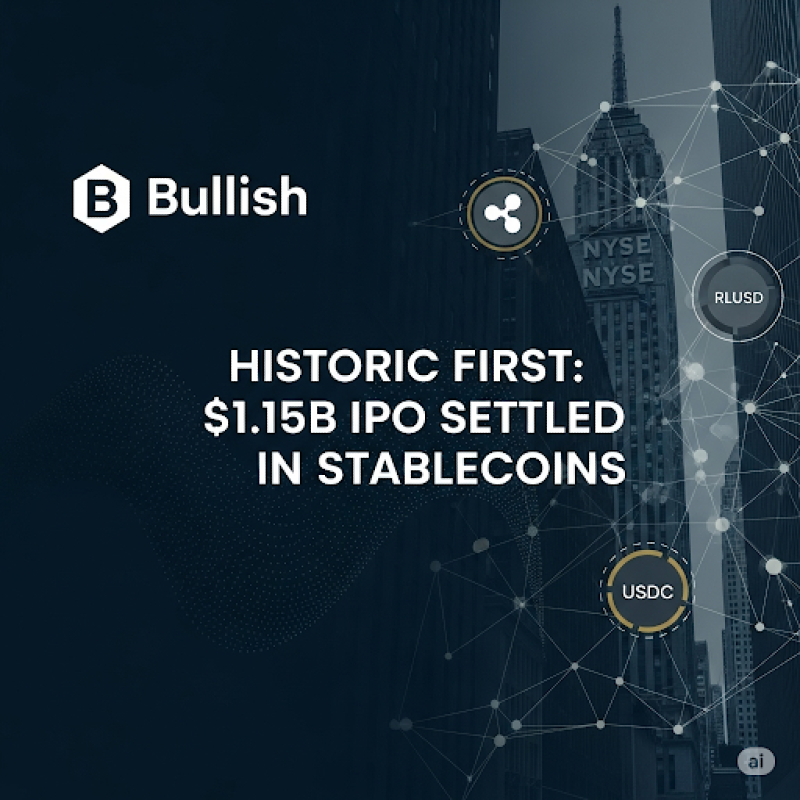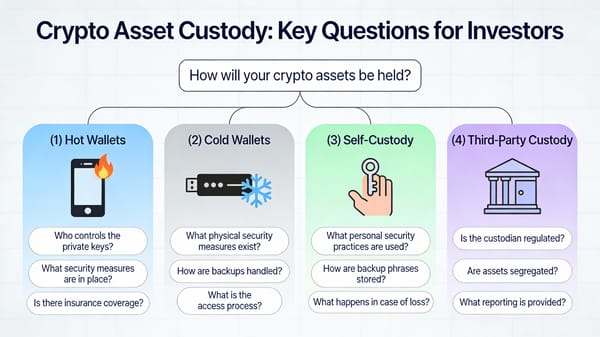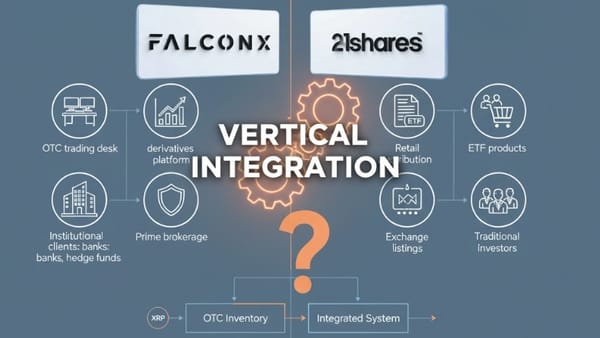Bullish Makes History: First-Ever IPO Settlement in Stablecoins
Bullish makes history as first public company to settle $1.15B IPO proceeds in stablecoins, including Ripple's RLUSD on XRP Ledger. This unprecedented blockchain settlement sets new precedent for traditional finance integration.

Digital asset exchange settles $1.15B IPO proceeds using RLUSD and other stablecoins, setting unprecedented precedent for blockchain-based capital markets
In a groundbreaking move that could reshape how companies go public, Bullish (NYSE: BLSH) announced that it arranged to receive $1.15 billion of proceeds from its recently completed initial public offering in stablecoins, marking the first public listing to integrate blockchain settlement directly into the IPO process.
The historic transaction showcased the real-world utility of stablecoins in traditional finance, with Ripple's RLUSD playing a key role alongside other digital currencies, including Circle's USDC, PayPal's PYUSD, Paxos's Global Dollar, and Societe Generale's Euro-backed tokens. This unprecedented settlement method demonstrates how blockchain technology is moving from experimental to essential in mainstream financial operations.
Bullish has arranged to receive $1.15 billion of proceeds from its recently completed initial public offering in stablecoins, which represents a historic step for the use of stablecoins in an initial public offering in the United States.https://t.co/hh9i22RS9I
— Bullish (@Bullish) August 19, 2025
Breaking Traditional Settlement Barriers
By bringing settlement onchain, Bullish showed how stablecoins can add speed, transparency, and efficiency to financial markets that have long depended on slower, costlier methods. Traditional IPO settlements typically involve only cash transactions and banking intermediaries, creating delays and additional costs through multiple layers of financial institutions.
The choice to receive IPO proceeds in stablecoins wasn't merely symbolic. Bullish's Chief Financial Officer, David Bonanno, said the company already uses stablecoins internally for fast, secure fund transfers. This IPO was simply a larger stage to demonstrate how blockchain can power global finance at scale.
Tom Farley, Bullish's CEO and former president of the NYSE Group, has been involved in crypto since 2014, when he led a $10 million Coinbase investment from the NYSE's balance sheet. Under his leadership, Bullish positions itself as a bridge between Wall Street and blockchain technology, with stablecoin integration as a foundational layer.
Regulatory Clarity Drives Innovation
The timing of this breakthrough settlement coincides with significant regulatory developments in the United States. The recently passed GENIUS Act (Guiding and Establishing National Innovation for U.S. Stablecoins Act) establishes a clear regulatory framework for payment stablecoins, requiring 1:1 reserve backing and compliance with anti-money laundering standards.
Under the GENIUS Act, stablecoin issuers must hold 1:1 reserves for any stablecoins issued, with reserves held in physical currency, US treasury bills, repurchase agreements and other low-risk assets approved by regulators. This regulatory certainty has transformed stablecoins from speculative tools into institutional-grade financial instruments.
The new regulatory framework has created confidence among institutional investors. Since 2025, firms like Fidelity and BlackRock have launched tokenized bond platforms and ETFs, resulting in an $85 billion surge in institutional crypto allocations.
XRP/Ripple Analysis: Strategic Positioning Pays Off
For Ripple and the broader XRP ecosystem, Bullish's historic IPO represents a major validation of their strategic positioning in the institutional payments space. According to CoinMarketCap data, Bullish accounts for over 76% of RLUSD trading volume split across different trading pairs RLUSD/USDC (40.86%), XRP/RLUSD (35.92%) and SOL/RLUSD (0.86%).
This development significantly enhances Ripple's competitive position in several key areas:
Market Validation: Ripple highlighted that using RLUSD in this IPO wasn't just symbolic, it set a precedent for how future listings might work. The successful use of RLUSD in a major IPO settlement provides concrete proof of concept for enterprise adoption.
Growing Market Cap: RLUSD's market cap has surged 26.31% over the past month to $666.57 million, reflecting increased institutional confidence following regulatory clarity and high-profile use cases like the Bullish IPO.
Strategic Expansion: Ripple is actively seeking to bolster RLUSD's dominance in the stablecoin market and recently acquired Rail for $200 million to advance this goal, positioning the company for expanded settlement services.
Partnership Pipeline: The success of this settlement could accelerate adoption among other exchanges and financial institutions. Gemini has already secured a $75 million credit facility from Ripple, with borrowing options denominated in RLUSD stablecoin once the facility exceeds the initial threshold.
Broader Market Implications
Bullish's successful stablecoin settlement creates a template for future public offerings. With regulatory clarity improving and companies willing to embrace blockchain innovation, the role of stablecoins in financial markets is likely to grow.
The development arrives amid a wave of crypto companies going public. Bullish raised $1.11 billion in its IPO, pricing 30 million shares at $37 each, well above the expected range, with backing from investors like BlackRock and ARK Investment Management. According to asset disclosures, Bullish holds over $3 billion in liquid assets, including 24,000 BTC, 12,600 ETH, and $418 million in cash and stablecoins.
This follows other successful crypto IPOs, including Circle Internet Group, which soared 168% after raising almost $1.1 billion in its IPO, pricing above the expected range at $31 per share.
Future Settlement Innovation
The implications extend beyond individual companies to the entire capital markets infrastructure. Institutions are now investing in custody solutions, cybersecurity, and cross-border payment platforms to capitalize on stablecoin-driven flows, with JPMorgan's tokenized bond platform already attracting $12 billion in institutional capital.
For investors and market participants, this development signals a fundamental shift in how capital markets operate. Bullish's IPO sets a precedent for others to follow. With regulatory clarity improving and companies willing to embrace blockchain innovation, the role of stablecoins in financial markets is likely to grow.
Key Takeaways
Bullish's historic IPO settlement in stablecoins represents more than a technological achievement—it demonstrates the maturation of blockchain-based financial infrastructure. The successful integration of RLUSD and other stablecoins into a major public offering provides concrete evidence that digital assets are transitioning from experimental to essential in mainstream finance.
For Ripple specifically, this milestone validates years of strategic investment in institutional-grade payment solutions and regulatory compliance. As stablecoins become standard settlement infrastructure, early movers like Ripple are positioned to capture significant market share in the evolving digital finance ecosystem.
The precedent set by Bullish's IPO will likely accelerate adoption across the industry, as other companies and exchanges recognize the efficiency gains and competitive advantages of blockchain-based settlement systems.
Sources:
- Bullish Official Announcement
- Ripple's RLUSD Makes History With Bullish Exchange's $1.15 Billion IPO - U.Today
- Bullish Makes History with IPO Settlement in Stablecoins - Coinpedia
- What the GENIUS Act Means for Payment Stablecoin Issuers - WilmerHale
- GENIUS Act Passes in US Congress - Morgan Lewis
- Bullish's IPO and the Reshaping of Crypto Infrastructure - AInvest
DISCLAIMER: This newsletter is for informational purposes only and does not constitute investment advice or a recommendation to buy, sell, or hold any securities. Investments in cryptocurrencies or other financial assets carry significant risks, including the potential for total loss, extreme volatility, and regulatory uncertainty. Past performance is not indicative of future results. Always consult a qualified financial professional and conduct thorough research before making any investment decisions.



